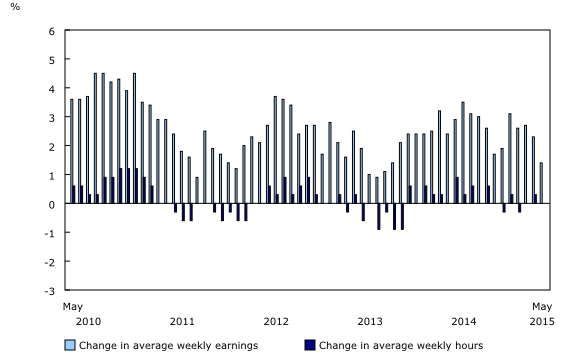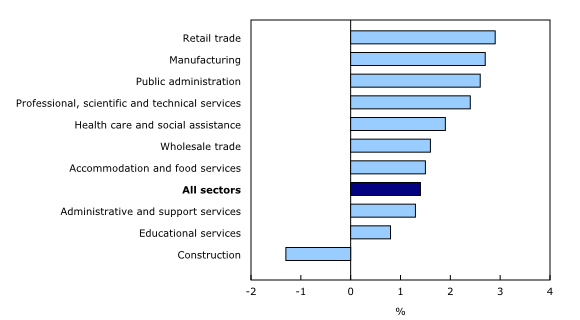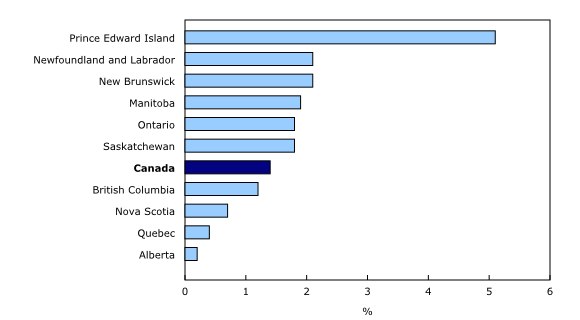Payroll employment, earnings and hours, May 2015
Archived Content
Information identified as archived is provided for reference, research or recordkeeping purposes. It is not subject to the Government of Canada Web Standards and has not been altered or updated since it was archived. Please "contact us" to request a format other than those available.
Released: 2015-07-30
$948.15
May 2015
1.4% 
(12-month change)
Average weekly earnings of non-farm payroll employees were $948 in May, down 0.6% from the previous month. Compared with 12 months earlier, weekly earnings increased by 1.4%, the lowest growth rate since October 2013.
The increase in weekly earnings compared with May 2014 reflected a number of factors, including wage growth, changes in the composition of employment by industry, occupation, and level of job experience, as well as average hours worked per week.
Non-farm payroll employees worked an average of 33.0 hours per week in May, unchanged from both the previous month and a year earlier.
Average weekly earnings by sector
In the 12 months to May, average weekly earnings increased in 5 of the 10 largest industrial sectors, led by retail trade, manufacturing and public administration. At the same time, earnings edged down in construction and were little changed in wholesale trade, accommodation and food services, administrative and support services, as well as educational services.
Average weekly earnings in retail trade rose 2.9% compared with 12 months earlier to $547, with most of the growth occurring between May and August 2014. Year-over-year gains were spread across most industries in this sector.
In the 12 months to May, average weekly earnings in manufacturing increased 2.7% to $1,070. The largest gains were in the manufacturing of paper, non-metallic mineral products, and computer and electronic products.
Average weekly earnings in public administration increased 2.6% compared with 12 months earlier to $1,225, with all of the gains occurring between August 2014 and March 2015. Year-over-year gains were widespread across this sector, led by Aboriginal public administration as well as local, municipal and regional public administration.
Weekly earnings in professional, scientific and technical services were up 2.4% to $1,341 in the 12 months to May. Earnings in this sector have levelled out since December 2014. Year-over-year earnings growth was widespread, led by management, scientific and technical consulting services, as well as accounting, tax preparation, bookkeeping and payroll services.
In construction, average weekly earnings edged down 1.3% to $1,216 in the 12 months to May, with losses in earnings in the construction of buildings subsector. Earnings in construction have been on a slight downward trend since September 2014.
Average weekly earnings by province
Year over year, average weekly earnings of non-farm payroll employees increased in seven provinces in May, with the highest growth in Prince Edward Island. At the same time, earnings were little changed in Nova Scotia, Alberta and Quebec.
Compared with May 2014, average weekly earnings in Prince Edward Island rose 5.1% to $796. Earnings growth was widespread, with the largest gains in manufacturing, transportation and warehousing, as well as finance and insurance.
Average weekly earnings in Newfoundland and Labrador were $1,011, up 2.1% compared with 12 months earlier, with the widespread gains led by transportation and warehousing.
In New Brunswick, average weekly earnings increased 2.1% to $848 in the 12 months to May, led by gains in professional, scientific and technical services, educational services, and retail trade.
Compared with 12 months earlier, average weekly earnings in Manitoba rose 1.9% to $877, with most of the growth occurring between May and August 2014. On a year-over-year basis, increases were led by transportation and warehousing.
In the 12 months to May, average weekly earnings in Ontario grew 1.8% to $954. The largest gains were in professional, scientific and technical services, retail trade, and manufacturing.
In Alberta, the pace of year-over-year earnings growth continued to slow (+0.2%), mostly because of declines in the high-earning mining, quarrying, and oil and gas sector. Year-over-year earnings growth in the province has slowed notably since the start of 2015.
Non-farm payroll employment by sector
The number of non-farm payroll jobs increased by 16,500 in May, following an increase of 27,600 in April. The largest gains in May were in accommodation and food services; construction; arts, entertainment and recreation; as well as administrative and support services. At the same time, there were fewer payroll jobs in health care and social assistance; mining, quarrying, and oil and gas extraction; and 'other services.'
Compared with 12 months earlier, the number of non-farm payroll employees increased by 175,700 or 1.1%. Over this period, the highest employment growth was in arts, entertainment and recreation (+3.9%), with all of the gains occurring since February. The second largest increase was in accommodation and food services (+3.0%).
Payroll employment fell by 7.9% in mining, quarrying, and oil and gas extraction in the 12 months to May. Since peaking in October 2014, employment in this sector has declined 9.3% or by 21,800, driven by losses in support activities for mining, and oil and gas extraction.
Note to readers
The Survey of Employment, Payrolls and Hours (SEPH) is produced by a combination of a census of payroll deductions, provided by the Canada Revenue Agency, and the Business Payrolls Survey, which collects data from a sample of 15,000 establishments. The key objective of SEPH is to provide a monthly portrait of the level of earnings, and the number of jobs and hours worked by detailed industry at the national, provincial and territorial level.
Estimates of average weekly earnings and hours worked are based on a sample and are therefore subject to sampling variability. This analysis focuses on differences between estimates that are statistically significant at the 68% confidence level. Payroll employment estimates are based on a census of administrative data and are not subject to sampling variability.
Statistics Canada also produces employment estimates from its Labour Force Survey (LFS). The LFS is a monthly household survey, the main objective of which is to divide the working-age population into three mutually exclusive groups: the employed (including the self-employed), unemployed and not in the labour force. This survey is the official source for the unemployment rate and collects data on the socio-demographic characteristics of all those in the labour market.
As a result of conceptual and methodological differences, estimates of changes from SEPH and LFS do differ from time to time. However, the trends in the data are quite similar.
Unless otherwise stated, this release presents seasonally adjusted data, which facilitate comparisons by removing the effects of seasonal variations. For more information on seasonal adjustment, see Seasonally adjusted data – Frequently asked questions.
Non-farm payroll employment data are for all hourly and salaried employees, as well as the "other employees" category, which includes piece-rate and commission-only employees.
Average weekly hours data are for hourly and salaried employees only and exclude businesses that could not be classified to a North American Industry Classification System (NAICS) code.
All earnings data include overtime pay and exclude businesses that could not be classified to a NAICS code. Earnings data are based on gross taxable payroll before source deductions. Average weekly earnings are derived by dividing total weekly earnings by the number of employees.
With each release, data for the current reference month are subject to revision. Data have been revised for the previous month. Users are encouraged to request and use the most up-to-date data for each month.
Next release
Data on payroll employment, earnings and hours for June will be released on August 27.
Products
A summary table is available from the Browse by key resource module of our website. Under Summary tables, choose Subject then Labour.
More information about the concepts and use of the Survey of Employment, Payrolls and Hours is available online in the Guide to the Survey of Employment, Payrolls and Hours (72-203-G), from the Browse by key resource module of our website under Publications.
Contact information
For more information, contact us (toll-free 1-800-263-1136; 514-283-8300; infostats@statcan.gc.ca).
To enquire about the concepts, methods or data quality of this release, contact Emmanuelle Bourbeau (613-951-3007; emmanuelle.bourbeau@statcan.gc.ca), Labour Statistics Division.
- Date modified:




